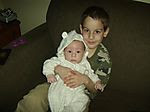From Amanda Riddings I want to learn about spina bifida blog
Learning about SB: A mile-o-what?
This is my first 'Spina Bifida Education Module' to help educate friends and family about spina bifida. I hope that these 'modules' will be posted over the month of June in celebration of Spina Bifida month. But don't worry! I will continue to post about the kiddies as well!
A myelomeningecele (pronounced my-low-men-ning-guh-seal). This is typically what spina bifida refers to, and is the most common type of spina bifida (there are 3 different types – also a meningecele and occulta). A Myelomeningecele is the most damaging, and this is what Nickolas was born with. This long word is what was wrong with my baby boy. In the hospital they shortened it to a MMC. Nickolas had an MMC repair – a lot easier to write out a million times in nursing notes.
I do not have a picture or know what Nicikolas’ looked like (I couldn’t visit because I had H1N1 and it never occurred to me to ask someone to take a picture), but I’ve seen other childrens. I was told by the neurosurgeon that Nickolas’ was 3 cm in diameter, but his scar is rather large (S shaped) compared to other children’s that I’ve seen.
This picture shows that the bones of the spine have split and allowed a sac to come out. The sac contains spinal fluid, the spinal cord (nerves) and meninges (tissue that covers the cord) to stick out and be exposed. Surgery is done (in Nickolas’ case) within 24 hours to replace the sac and nerves in the back and cover it with skin (I was surprised but the skin and muscle keep it in place, no other bone was put to cover what is missing).
As you can imagine it is delicate and major surgery that these kids go through and recover (amazingly) within their first few days of life. Even after surgery there has been damage to the nerves that are not, and cannot be repaired. The amount of damage done and what is affected depends on what nerves were damaged and what nerves passed through. Typically the level of the lesion (the hole) can determine what function is affected, but children may function at a different level than their lesion.
And usually there is a chart that typically gives an idea of mobility future and need for assistance with walking that goes along with the picture.
Nickolas’ sac/lesion/level is S1 when they did the surgery. We are still waiting to see what level he will function at (or not – who needs labels to say what they can and cannot do).
So that is my first quick-start education module – hope you liked it.
The spinal picture and walking chart were taken from http://www.spinabifidamoms.com/english/about.html
The picture of the myelomeningocele came from http://health.allrefer.com/pictures-images/spina-bifida-degrees-of-severity.html
Tuesday, July 27, 2010
Subscribe to:
Post Comments (Atom)








0 comments:
Post a Comment